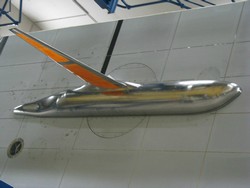High Speed Wind Tunnel test on a laminar wing
The development of aircraft with extended natural laminar flow (NLF) on its surface represents the most promising path to a substantial reduction of drag. The objective of the NLF-WINGHIPER (NLF wing high speed performance test) project was to investigate the effect of surface imperfections on the development and stability of laminar flow. Researchers exploited the European Transonic Windtunnel (ETW) capabilities to investigate the impact of wing surface imperfections such as surface steps and surface waviness on aircraft performance. The wind tunnel tests covered Mach numbers from M=0.73 up to M=0.77 in 0.01 increments and Reynolds numbers of 6, 9, 12 and 16 million. The model featured a separate internal pressure control system and pressure measurement for local control of the wing shape. The instrumentation of the half-model comprised conventional pressure taps on both sides of the wing and the half fuselage temperature sensitive paint (TSP) coated wing surfaces as well as a 6-component balance, accelerometers and markers for optical wing deformation measurement. TSP images were taken at a number of lift values allowing for an eventual correction of drag data acquired by the balance as part of the post-processing procedure. Special attention was given to a suitable surface quality of the TSP, as small imperfections can affect results. This allowed for a comparison of performance results gathered for different surface quality conditions like tiny transition bands at different chord positions. It also provided a platform for correction of drag due to accidentally appearing turbulent wedges. The surface quality, especially in the region of the leading edge, was inspected before and after each test block. On a real aircraft, steps, waviness (either from manufacturing or deformation under cruise loads), 3D disturbances (by insects or rivet heads), and roughness at the leading edge (either from manufacturing or erosion under operational conditions) are seen as a design challenge. At the end of the testing knowledge of the sensitivity of laminar flow development over wings to local shape imperfections was improved considerably. The results will allow specifying manufacturing tolerances and surface finish for real aircraft.
Keywords
Wings, wind tunnel testing, aircraft, high speed, natural laminar flow, NLF-WINGHIPER, temperature sensitive paint, surface finish

